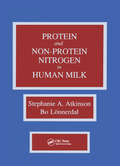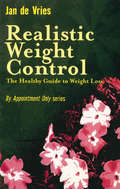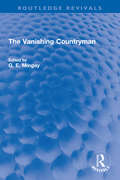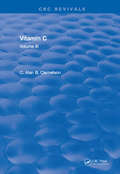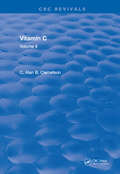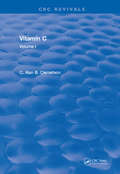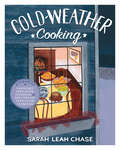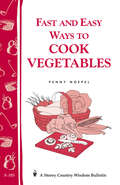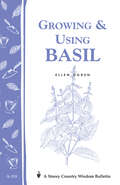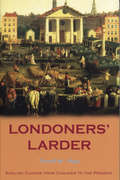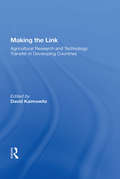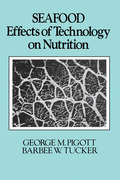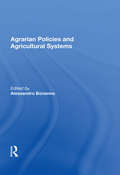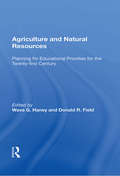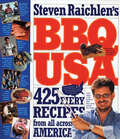- Table View
- List View
Proteins and Non-protein Nitrogen in Human Milk
by Stephanie Atkinson Bo LonnerdalFor the first time, an entire publication has been dedicated to providing a critical review of the identification and analysis of the milk specific proteins such as lactalbumin, lactoferrin and casein; the non-milk specific proteins such as plasma and membrane proteins; and the minor nitrogen-containing components such as enzymes, hormones, and growth factors. Biological roles, whether nutritional, endocrinological or immunological, of the specific nitrogen compounds in mammary milk production and/or growth and development of the breast-fed infant are also presented. Identification of the molecular weight compounds that have led to questions about their function in milk and their inclusion in modern infant formulas is thoroughly discussed and of great value to scientists in sub-specialties of biochemistry, nutrition, physiology and immunology, as well as to pediatric practitioners with primary interests in the infant food industry, academia, or clinical nutrition. The thoroughness of each chapter, often providing an historical panorama of the specific aspect of milk composition, makes this book useful for both the uninitiated and expert audiences who are interested in advancing their knowledge of human milk biochemistry and its physiological significance to the recipient infant.
Proteins and Non-protein Nitrogen in Human Milk
by Stephanie Atkinson Bo LonnerdalFor the first time, an entire publication has been dedicated to providing a critical review of the identification and analysis of the milk specific proteins such as lactalbumin, lactoferrin and casein; the non-milk specific proteins such as plasma and membrane proteins; and the minor nitrogen-containing components such as enzymes, hormones, and growth factors. Biological roles, whether nutritional, endocrinological or immunological, of the specific nitrogen compounds in mammary milk production and/or growth and development of the breast-fed infant are also presented. Identification of the molecular weight compounds that have led to questions about their function in milk and their inclusion in modern infant formulas is thoroughly discussed and of great value to scientists in sub-specialties of biochemistry, nutrition, physiology and immunology, as well as to pediatric practitioners with primary interests in the infant food industry, academia, or clinical nutrition. The thoroughness of each chapter, often providing an historical panorama of the specific aspect of milk composition, makes this book useful for both the uninitiated and expert audiences who are interested in advancing their knowledge of human milk biochemistry and its physiological significance to the recipient infant.
Realistic Weight Control: The Healthy Guide to Weight Loss (By Appointment Only Ser.)
by Jan De VriesWhatever you might call it - being overweight or corpulent or carrying excess fat - one thing is certain: obesity is one of the major problems of the developed world today. It is not simply a matter of being too fat: those who are severely overweight are prone to a tremendous range of other health problems such as back pain and coronary heart disease. In Realistic Weight Control Jan de Vries clearly and sensibly explains why these problems occur and how best to avoid them. Moreover, in view of the overwhelming variety of slimming methods on the market, each claiming to be better than the last, he points out the dangers to health caused by following an inappropriate diet.
The Vanishing Countryman (Routledge Revivals)
by G. E. MingayFirst published in 1989, The Vanishing Countryman investigates how farmers, farm workers, and other country crafts- and tradespeople have fared in response to significant changes across the British countryside in the past one hundred years. The book explores the move towards large-scale and capital-intensive farming, and the conflict between increased production and damage to the environment. It looks at the decline in the number of farm workers, crafts- and tradespeople. It also considers the changes in social composition across country villages and the impact that this has had on living standards, housing, and transport. The Vanishing Countryman will appeal to those with an interest in rural and social history, and in the history of the British countryside specifically.
The Vanishing Countryman (Routledge Revivals)
by G. E. MingayFirst published in 1989, The Vanishing Countryman investigates how farmers, farm workers, and other country crafts- and tradespeople have fared in response to significant changes across the British countryside in the past one hundred years. The book explores the move towards large-scale and capital-intensive farming, and the conflict between increased production and damage to the environment. It looks at the decline in the number of farm workers, crafts- and tradespeople. It also considers the changes in social composition across country villages and the impact that this has had on living standards, housing, and transport. The Vanishing Countryman will appeal to those with an interest in rural and social history, and in the history of the British countryside specifically.
Vitamin C: Volume III
by Alan B. ClemetsonThe factors affecting blood vitamin C levels are described in detail in this series. Many factors such as aging, smoking, infection, trauma, surgery, hemolysis, hormone administration, heavy metals, pregnancy, alcohol, ionizing radiation and several medicines have been found to cause a disturbance of ascorbic acid metabolism and to reduce blood vitamin C levels. Indeed, abnormalities of ascorbic acid metabolism, due to factors such as smoking, occur much more frequently than does dietary vitamin C deficiency today.It is now known that low blood vitamin C levels are associated with histaminemia (high blood histamine levels), and also that ascorbate-responsive histaminemia is common in apparently healthy people. High blood histamine levels are believed to cause small hemorrhages within the inner walls of the blood vessels and these may lead to the deposition of cholesterol, as an aberrant form of wound healing. Ascorbic acid not only reduces blood histamine levels, but also aids the conversion of cholesterol to bile acids in the liver. The clinical pathological and chemical changes observed in ascorbic acid deficiency are discussed in detail. Several diseases and disorders associated with low blood vitamin C levels are also described. Possible toxic effects resulting from the oxidation of ascorbic acid are noted, and reasons for the use of D-catechin or other chelating fiber to prevent or minimize the release of ascorbate-free radical are detailed. An excellent reference for physicians, nutritionists and other scientists
Vitamin C: Volume III
by Alan B. ClemetsonThe factors affecting blood vitamin C levels are described in detail in this series. Many factors such as aging, smoking, infection, trauma, surgery, hemolysis, hormone administration, heavy metals, pregnancy, alcohol, ionizing radiation and several medicines have been found to cause a disturbance of ascorbic acid metabolism and to reduce blood vitamin C levels. Indeed, abnormalities of ascorbic acid metabolism, due to factors such as smoking, occur much more frequently than does dietary vitamin C deficiency today.It is now known that low blood vitamin C levels are associated with histaminemia (high blood histamine levels), and also that ascorbate-responsive histaminemia is common in apparently healthy people. High blood histamine levels are believed to cause small hemorrhages within the inner walls of the blood vessels and these may lead to the deposition of cholesterol, as an aberrant form of wound healing. Ascorbic acid not only reduces blood histamine levels, but also aids the conversion of cholesterol to bile acids in the liver. The clinical pathological and chemical changes observed in ascorbic acid deficiency are discussed in detail. Several diseases and disorders associated with low blood vitamin C levels are also described. Possible toxic effects resulting from the oxidation of ascorbic acid are noted, and reasons for the use of D-catechin or other chelating fiber to prevent or minimize the release of ascorbate-free radical are detailed. An excellent reference for physicians, nutritionists and other scientists
Vitamin C: Volume II
by Alan B. ClemetsonThe factors affecting blood vitamin C levels are described in detail in this series. Many factors such as aging, smoking, infection, trauma, surgery, hemolysis, hormone administration, heavy metals, pregnancy, alcohol, ionizing radiation and several medicines have been found to cause a disturbance of ascorbic acid metabolism and to reduce blood vitamin C levels. Indeed, abnormalities of ascorbic acid metabolism, due to factors such as smoking, occur much more frequently than does dietary vitamin C deficiency today.It is now known that low blood vitamin C levels are associated with histaminemia (high blood histamine levels), and also that ascorbate-responsive histaminemia is common in apparently healthy people. High blood histamine levels are believed to cause small hemorrhages within the inner walls of the blood vessels and these may lead to the deposition of cholesterol, as an aberrant form of wound healing. Ascorbic acid not only reduces blood histamine levels, but also aids the conversion of cholesterol to bile acids in the liver. The clinical pathological and chemical changes observed in ascorbic acid deficiency are discussed in detail. Several diseases and disorders associated with low blood vitamin C levels are also described. Possible toxic effects resulting from the oxidation of ascorbic acid are noted, and reasons for the use of D-catechin or other chelating fiber to prevent or minimize the release of ascorbate-free radical are detailed. An excellent reference for physicians, nutritionists and other scientists
Vitamin C: Volume I
by Alan B. ClemetsonThe factors affecting blood vitamin C levels are described in detail in this series. Many factors such as aging, smoking, infection, trauma, surgery, hemolysis, hormone administration, heavy metals, pregnancy, alcohol, ionizing radiation and several medicines have been found to cause a disturbance of ascorbic acid metabolism and to reduce blood vitamin C levels. Indeed, abnormalities of ascorbic acid metabolism, due to factors such as smoking, occur much more frequently than does dietary vitamin C deficiency today.It is now known that low blood vitamin C levels are associated with histaminemia (high blood histamine levels), and also that ascorbate-responsive histaminemia is common in apparently healthy people. High blood histamine levels are believed to cause small hemorrhages within the inner walls of the blood vessels and these may lead to the deposition of cholesterol, as an aberrant form of wound healing. Ascorbic acid not only reduces blood histamine levels, but also aids the conversion of cholesterol to bile acids in the liver. The clinical pathological and chemical changes observed in ascorbic acid deficiency are discussed in detail. Several diseases and disorders associated with low blood vitamin C levels are also described. Possible toxic effects resulting from the oxidation of ascorbic acid are noted, and reasons for the use of D-catechin or other chelating fiber to prevent or minimize the release of ascorbate-free radical are detailed. An excellent reference for physicians, nutritionists and other scientists
Vitamin C: Volume I
by Alan B. ClemetsonThe factors affecting blood vitamin C levels are described in detail in this series. Many factors such as aging, smoking, infection, trauma, surgery, hemolysis, hormone administration, heavy metals, pregnancy, alcohol, ionizing radiation and several medicines have been found to cause a disturbance of ascorbic acid metabolism and to reduce blood vitamin C levels. Indeed, abnormalities of ascorbic acid metabolism, due to factors such as smoking, occur much more frequently than does dietary vitamin C deficiency today.It is now known that low blood vitamin C levels are associated with histaminemia (high blood histamine levels), and also that ascorbate-responsive histaminemia is common in apparently healthy people. High blood histamine levels are believed to cause small hemorrhages within the inner walls of the blood vessels and these may lead to the deposition of cholesterol, as an aberrant form of wound healing. Ascorbic acid not only reduces blood histamine levels, but also aids the conversion of cholesterol to bile acids in the liver. The clinical pathological and chemical changes observed in ascorbic acid deficiency are discussed in detail. Several diseases and disorders associated with low blood vitamin C levels are also described. Possible toxic effects resulting from the oxidation of ascorbic acid are noted, and reasons for the use of D-catechin or other chelating fiber to prevent or minimize the release of ascorbate-free radical are detailed. An excellent reference for physicians, nutritionists and other scientists
Vitamin C: Volume II
by Alan B. ClemetsonThe factors affecting blood vitamin C levels are described in detail in this series. Many factors such as aging, smoking, infection, trauma, surgery, hemolysis, hormone administration, heavy metals, pregnancy, alcohol, ionizing radiation and several medicines have been found to cause a disturbance of ascorbic acid metabolism and to reduce blood vitamin C levels. Indeed, abnormalities of ascorbic acid metabolism, due to factors such as smoking, occur much more frequently than does dietary vitamin C deficiency today.It is now known that low blood vitamin C levels are associated with histaminemia (high blood histamine levels), and also that ascorbate-responsive histaminemia is common in apparently healthy people. High blood histamine levels are believed to cause small hemorrhages within the inner walls of the blood vessels and these may lead to the deposition of cholesterol, as an aberrant form of wound healing. Ascorbic acid not only reduces blood histamine levels, but also aids the conversion of cholesterol to bile acids in the liver. The clinical pathological and chemical changes observed in ascorbic acid deficiency are discussed in detail. Several diseases and disorders associated with low blood vitamin C levels are also described. Possible toxic effects resulting from the oxidation of ascorbic acid are noted, and reasons for the use of D-catechin or other chelating fiber to prevent or minimize the release of ascorbate-free radical are detailed. An excellent reference for physicians, nutritionists and other scientists
Cold-Weather Cooking
by Sarah Leah ChaseWhether your winter blows with snow and rain or is just a sunbelt state of mind, a trove of delicious, soul-warming fare awaits in COLD WEATHER COOKING, from the author of The Nantucket Open-House Cookbook with over 214,000 copies in print. Guided by a sense that winter is the season for seasonings-from ginger, garlic, and rosemary in Mixed Winter Squash Provencal to the cilantro and walnut crust on a dazzling Roast Rack of Lamb-this gifted cook and author provides dishes that are even gutsier than her summertime favorites. She pays special attention to the late harvest, helps cooks make the most of fall fruits and vegetables, offers chapters on winter grilling and cooking over the hearth. More than 300 recipes range from bracing drinks for the first sign of autumn to glorious spring dishes for an Easter celebration. Warm Tomato Pie. Wild Rice, Mushroom, and Oyster Bisque. Pasta with Gorgonzola and Spinach. Plus Scallops in Sweet and Hot Lime Sauce, Deviled Beef Ribs, Broccoli with Toasted Hazelnuts and Pancetta, Sweet Potato Pancakes, Pumpkin Bread Pudding, Chestnut Mousse Cake, and Christmas Truffle Tart. Selection of the Book-of-the-Month Club's HomeStyle Books. 112,000 copies in print.
Fast and Easy Ways to Cook Vegetables: Storey Country Wisdom Bulletin A-105 (Storey Country Wisdom Bulletin)
by Penny NoepelSince 1973, Storey's Country Wisdom Bulletins have offered practical, hands-on instructions designed to help readers master dozens of country living skills quickly and easily. There are now more than 170 titles in this series, and their remarkable popularity reflects the common desire of country and city dwellers alike to cultivate personal independence in everyday life.
Growing & Using Basil: Storey's Country Wisdom Bulletin A-119 (Storey Country Wisdom Bulletin)
by Ellen Ecker OgdenEVERYTHING YOU EVER WANTED TO KNOW ABOUT BASIL – AND MORE! Basil is one of the most popular and widely grown herbs in the world. With its delicate aroma and sweet-spicy flavor, it’s no wonder that basil, a staple in kitchens around the world, is the favorite culinary herb of today’s chefs!In Growing & Using Basil, Ellen Ogden offers all the information you'll need to grow, harvest, and cook with basil in all its varieties of flavor. Whatever the basil you want to grow--sweet, purple, opal, lemon, cinnamon, anise, napoleatano, camphor, holy, or something more exotic--the information you need is right at your fingertips. Better still, you'll find dozens of recipes for using your basil in everything from pestos and basil vinegars to grilled bluefish wrapped in mammoth basil leaves and cinnamon basil custard.
Londoners' Larder: English Cuisine from Chaucer to the Present
by Annette HopeIn a vivid panorama, Londoner's Larder presents the food of a great city. Annette Hope has used biography, literature and social history to explore the city of Chaucer, Shakespeare, Pepys, Johnson, Dickens, Wilde and Virginia Woolf, and to show in lively detail what these writers and their contemporaries might have eaten, where the food came from and how it was cooked. She looks at problems of supply, distribution, nutrition, cooking, and health and hygiene as the city expanded and changed character, and chronicles the effects of social, economic, and ethnic shifts since the end of the Second World War. At the end of each chapter are recipes from the period, written in modern, usable form.From the takeaway pasties baked by the Cook in The Canterbury Pilgrims to dinner at the Café Royal, from John Evelyn's recipes for salads to Mrs Beeton, from the introduction of coffee to the appearance of ration books, this book charts the gastronomic life of London in scholarly and entertaining detail. A discussion of the city as it is at the beginning of the twenty-first century rounds off the picture - a time when Middle Eastern and Oriental food is commonplace, and much of the cuisine available in European restaurants is inspired by that on offer in popular holiday resorts and purely 'British' food is difficult to find. If London beguiles you, literature seduces you, and recipes fascinate you, this pioneering book will intrigue and delight you.
Making The Link: Agricultural Research And Technology Transfer In Developing Countries
by David KaimowitzThis book is about International Service for National Agricultural Research's (ISNAR) study to identify key factors that influenced the effectiveness and efficiency of links between research and technology transfer. It recommends ways to improve these links and reflects the progress made till date.
Making The Link: Agricultural Research And Technology Transfer In Developing Countries
by David KaimowitzThis book is about International Service for National Agricultural Research's (ISNAR) study to identify key factors that influenced the effectiveness and efficiency of links between research and technology transfer. It recommends ways to improve these links and reflects the progress made till date.
Seafood: Effects of Technology on Nutrition (Food Science And Technology Ser. #39)
by George M. Pigott Barbara TuckerAnalyzes how the technology and commercial practices of cultivation affect the nutritive value of certain fish, molluscs, crustacea, and freshwater plants. Organized to reflect the sequence from growth, harvest, and capture, through transportation, storage, and processing, to packaging and distribut
Seafood: Effects of Technology on Nutrition
by George M. Pigott Barbara TuckerAnalyzes how the technology and commercial practices of cultivation affect the nutritive value of certain fish, molluscs, crustacea, and freshwater plants. Organized to reflect the sequence from growth, harvest, and capture, through transportation, storage, and processing, to packaging and distribut
A Year in Provence (Popular Penguins Series)
by Peter MayleThe bestselling, much-loved classic account of an English couple enjoying the fruits of French rural living - an irresistible feast of humour and heart.Peter Mayle and his wife did what most of us only imagine doing when they made their long-cherished dream of a life abroad a reality: throwing caution to the wind, they bought a glorious two hundred year-old farmhouse in the Lubéron Valley and began a new life.In a year that begins with a marathon lunch and continues with a host of gastronomic delights, they also survive the unexpected and often hilarious curiosities of rural life. From mastering the local accent and enduring invasion by bumbling builders, to discovering the finer points of boules and goat-racing, all the earthy pleasures of Provençal life are conjured up in this enchanting portrait.'One of the most successful travel books of all time... Mayle created a new travel genre' GuardianDelightful' Washington Post'Engaging, funny and richly appreciative' New York Times Book Review'Stylish, witty, delightfully readable' Sunday Times'I really loved this book' Julia Child
Agrarian Policies And Agricultural Systems
by Alessandro BonannoThis book is a comparative analysis of the agrarian policies and the agricultural systems of the European Community (EC) and the United States (US). It provides an overview of the agricultural policies of the EC and US, their stated objectives, and their impact on both agricultural sectors.
Agrarian Policies And Agricultural Systems
by Alessandro BonannoThis book is a comparative analysis of the agrarian policies and the agricultural systems of the European Community (EC) and the United States (US). It provides an overview of the agricultural policies of the EC and US, their stated objectives, and their impact on both agricultural sectors.
Agriculture And Natural Resources: Planning For Educational Priorities For The Twenty-first Century
by Wava G. HaneyThis book identifies issues and trends in agriculture, natural resources, and rural communities in the context of topical strategic planning. It portrays both the process of planning and the substantive content driving a planning process. .
Agriculture And Natural Resources: Planning For Educational Priorities For The Twenty-first Century
by Wava G. Haney Donald R. FieldThis book identifies issues and trends in agriculture, natural resources, and rural communities in the context of topical strategic planning. It portrays both the process of planning and the substantive content driving a planning process. .
BBQ USA: 425 Fiery Recipes from All Across America
by Steven RaichlenSteven Raichlen, a national barbecue treasure and author of The Barbecue! Bible, How to Grill, and other books in the Barbecue! Bible series, embarks on a quest to find the soul of American barbecue, from barbecue-belt classics-Lone Star Brisket, Lexington Pulled Pork, K.C. Pepper Rub, Tennessee Mop Sauce-to the grilling genius of backyards, tailgate parties, competitions, and local restaurants. In 450 recipes covering every state as well as Canada and Puerto Rico, BBQ USA celebrates the best of regional live-fire cooking. Finger-lickin' or highfalutin; smoked, rubbed, mopped, or pulled; cooked in minutes or slaved over all through the night, American barbecue is where fire meets obsession. There's grill-crazy California, where everything gets fired up - dates, Caesar salad, lamb shanks, mussels. Latin-influenced Florida, with its Chimichurri Game Hens and Mojo-Marinated Pork on Sugar Cane. Maple syrup flavors the grilled fare of Vermont; Wisconsin throws its kielbasa over the coals; Georgia barbecues Vidalias; and Hawaii makes its pineapples sing. Accompanying the recipes are hundreds of tips, techniques, sidebars, and pit stops. It's a coast-to-coast extravaganza, from soup (grilled, chilled, and served in shooters) to nuts (yes, barbecued peanuts, from Kentucky).
